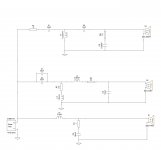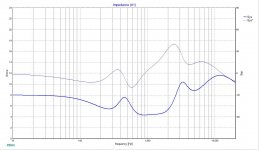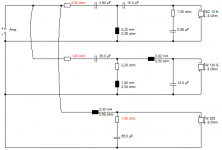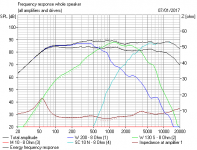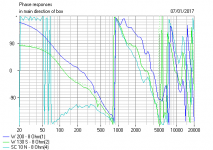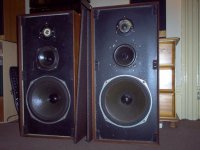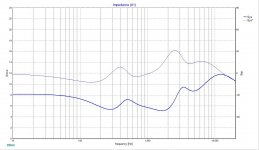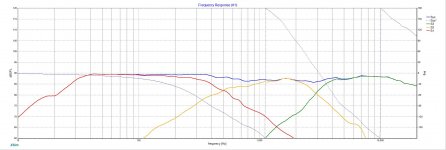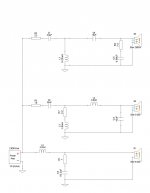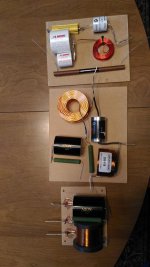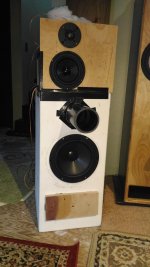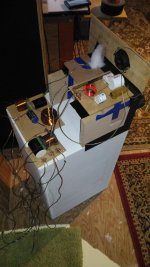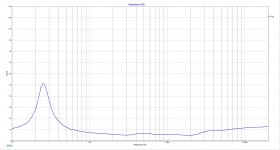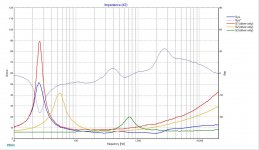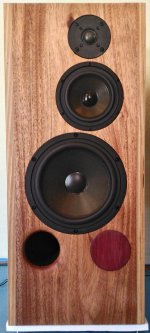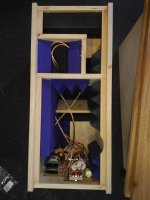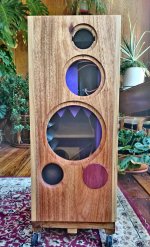Hi there!
I fixed the zobel on the tweeter...Thanks for your suggestion system7!
Oh! and I have been playing around with a resistor before the mid, and it does nicely raise the impedance.
I think I may be learnin'!(at least a little)
This is great!
Attached are the pics from the current design.
I need to trace the impedance to a zma file for each driver still.
Does that make my current impedance graph useless for now?
-Jazz
I fixed the zobel on the tweeter...Thanks for your suggestion system7!
Oh! and I have been playing around with a resistor before the mid, and it does nicely raise the impedance.
I think I may be learnin'!(at least a little)
This is great!
Attached are the pics from the current design.
I need to trace the impedance to a zma file for each driver still.
Does that make my current impedance graph useless for now?
-Jazz
Attachments
The interaction between crossover components and FR depends on the actual impedance. If you use a flat impedance instead of the real one, also the FR simulation will be off.I need to trace the impedance to a zma file for each driver still.
Does that make my current impedance graph useless for now?
Ralf
I've run with your current design here. Let's remind ourselves we are using Troels Gravesens' SEAS-3-Way-Classic as a sort of off-the-shelf crossover. TBH, I always get confused whether he's using the CA22RNY or the lower inductance CA22RNX.

The impedance is fairly predictable, and is better with a 1.8R (the solid line) in front of the mid filter, than a 2.2R after the shunt (the dotted line). Visaton Boxsim is my simulator of choice here.
In fact the only main variables which will knock this filter into shape for YOUR drivers, are the three marked in red. The drivers I have simmed are electrically similar to yours. The value changes you have made are almost insignificant. I doubt if you'd even hear the difference.
You can see a flattish impedance that will cause no difficulty to almost any amplifier, and the good power response and dispersion that we expect from a 3 way. Phase alignment is pretty good too.

The impedance is fairly predictable, and is better with a 1.8R (the solid line) in front of the mid filter, than a 2.2R after the shunt (the dotted line). Visaton Boxsim is my simulator of choice here.
In fact the only main variables which will knock this filter into shape for YOUR drivers, are the three marked in red. The drivers I have simmed are electrically similar to yours. The value changes you have made are almost insignificant. I doubt if you'd even hear the difference.
You can see a flattish impedance that will cause no difficulty to almost any amplifier, and the good power response and dispersion that we expect from a 3 way. Phase alignment is pretty good too.
Attachments
Thanks you all so much! I am grateful for all help. I am going to learn how to use Boxsim right now!
I hope this link to a great song will inspire you all to keep building, and make your ears(and speakers) smile: https://www.youtube.com/watch?v=jLRw-Ahq22k
It's called The Curtain by Snarky Puppy and The Metropole Orkest.
I hope this link to a great song will inspire you all to keep building, and make your ears(and speakers) smile: https://www.youtube.com/watch?v=jLRw-Ahq22k
It's called The Curtain by Snarky Puppy and The Metropole Orkest.
So it looks like I am gonna use the Troels crossover, slightly tweeked as system7 posted above. Then build a cheap cab to test them out, MEASURE, then build better cabs and adjust the crossover as needed...
Sound good?
Do you all think I should start a NEW thread to talk about the cab size I have planed?(to get advice/help)
Sound good?
Do you all think I should start a NEW thread to talk about the cab size I have planed?(to get advice/help)
Major Ninth, PLEASE don't start a new thread. 😱
I have enough trouble with every stray cat that turns up on my doorstep demanding food. It's endless. 😀
Here's my opinion. You're unusually ahead of the game in having chosen fairly sensible and high quality drivers to build a three way. I think you will succeed, though a three way is a fairly complex constructional project. Three ways are an excellent idea, going loud effortless and with less distortion than two ways.
What I can tell you about your 8" bass unit is that it is a closed box driver:
https://www.hifisound.de/en/Do-it-yourself-Products/Eton-8-402-C8-32-HEX-Sandwich.html. The Qts of 0.47 tells me this. The Vas is a very approximate 86L. The Fs is an unusually low 24Hz, so it's a big old heavy cone with some serious bass.
So a box like Troels' classic with about 30-90L of volume and no port is OK. I'd guess 50L has some wife approval factor. I'd stick to the dimensions of his front baffle and the layout.
Troels actually uses a 4" mid (you have a 5") here. But still a 1" tweeter. If I had to guess the actual resistor values that get this sounding good, I'd have to look at the SPL levels of Troels' drivers, versus yours. It's all about decibels. 3dB is twice as loud. Generally speaking, every ohm at the front of a filter added reduces decibels 1dB.
About 50 years ago, old engineers like me had a wonderful factory device called a Decade Box. They would just wire these adjustable coils, caps and resistors together and fiddle with values until the whole thing sounded sweet. This was how my pictured Celestion Ditton 44 oldies were designed. An excellent and loud speaker. Trial and error with a basic understanding of what is trying to be achieved. But it can be done. 😀
I have enough trouble with every stray cat that turns up on my doorstep demanding food. It's endless. 😀
Here's my opinion. You're unusually ahead of the game in having chosen fairly sensible and high quality drivers to build a three way. I think you will succeed, though a three way is a fairly complex constructional project. Three ways are an excellent idea, going loud effortless and with less distortion than two ways.
What I can tell you about your 8" bass unit is that it is a closed box driver:
https://www.hifisound.de/en/Do-it-yourself-Products/Eton-8-402-C8-32-HEX-Sandwich.html. The Qts of 0.47 tells me this. The Vas is a very approximate 86L. The Fs is an unusually low 24Hz, so it's a big old heavy cone with some serious bass.
So a box like Troels' classic with about 30-90L of volume and no port is OK. I'd guess 50L has some wife approval factor. I'd stick to the dimensions of his front baffle and the layout.
Troels actually uses a 4" mid (you have a 5") here. But still a 1" tweeter. If I had to guess the actual resistor values that get this sounding good, I'd have to look at the SPL levels of Troels' drivers, versus yours. It's all about decibels. 3dB is twice as loud. Generally speaking, every ohm at the front of a filter added reduces decibels 1dB.
About 50 years ago, old engineers like me had a wonderful factory device called a Decade Box. They would just wire these adjustable coils, caps and resistors together and fiddle with values until the whole thing sounded sweet. This was how my pictured Celestion Ditton 44 oldies were designed. An excellent and loud speaker. Trial and error with a basic understanding of what is trying to be achieved. But it can be done. 😀
Attachments
Last edited:
Again, Great advice system7.
I just compared my graph and Troels'.
They look very close for different drivers.
just wondering if I should lower the mid level and tweet to compensate for BSL, like 2db or so...
Cause it looks like Troels graph I compared mine to is in the Cab.
Wow! I am very grateful to you all, and excited to begin this project.
Thanks a bunch!
-Jazz ♪♫
I just compared my graph and Troels'.
They look very close for different drivers.
just wondering if I should lower the mid level and tweet to compensate for BSL, like 2db or so...
Cause it looks like Troels graph I compared mine to is in the Cab.
Wow! I am very grateful to you all, and excited to begin this project.
Thanks a bunch!
-Jazz ♪♫
I don't see much in it between the MCA12RC H1304-08 MCA12RC and your Eton 5-200/A8 https://www.madisoundspeakerstore.com/approx-5-woofers/eton-5-200/a8-symphony-5-mid/bass/
Both about 86dB loudness.
The Eton 25SD4 tweeter is a 90db type, the 27TFFC is 91dB. Nothing in it. The exact Zobel for a 0.02mH/6.5R tweeter is 0.33uF/8.2R, but these things aren't critical. The modelling tells you what is going on. http://www.diyaudioandvideo.com/Calculator/ImpedanceEqualizationCircuit/
Your woofer was an 89dB type, which must be close to the H1288-08 CA22RNX
I don't know how good your sim actually is, but Troels' crossover can't be far off at all.
Both about 86dB loudness.
The Eton 25SD4 tweeter is a 90db type, the 27TFFC is 91dB. Nothing in it. The exact Zobel for a 0.02mH/6.5R tweeter is 0.33uF/8.2R, but these things aren't critical. The modelling tells you what is going on. http://www.diyaudioandvideo.com/Calculator/ImpedanceEqualizationCircuit/
Your woofer was an 89dB type, which must be close to the H1288-08 CA22RNX
I don't know how good your sim actually is, but Troels' crossover can't be far off at all.
Last edited:
Well here is my current version of Troel's crossover design, for my speakers.🙂
Next up is getting some proper measurement hardware, and build a test cab.
Question: I need to make a choice between an air core inductor with a value of 3.3mh and .66DCR to put on the woofer and a 3.3mh steal lam core with .13DCR.
The steal core's low DCR seem to be better on the graph, as it keeps the woofers level up by at least 1db.
But I just want to know, as they are close to the same cost, how apparent is the difference?
The FR graph below has the lower DCR value.
ERSE-EQ
ERSE - Super Q
Much Thanks!
-Jazz♪♫
Next up is getting some proper measurement hardware, and build a test cab.
Question: I need to make a choice between an air core inductor with a value of 3.3mh and .66DCR to put on the woofer and a 3.3mh steal lam core with .13DCR.
The steal core's low DCR seem to be better on the graph, as it keeps the woofers level up by at least 1db.
But I just want to know, as they are close to the same cost, how apparent is the difference?
The FR graph below has the lower DCR value.
ERSE-EQ
ERSE - Super Q
Much Thanks!
-Jazz♪♫
Attachments
Last edited:
Well, I might have answered my own question...It looks from Troels parts list, the steal core is used....still interested in all ya'll's expertise.
Test setup...
Hi all,
I Just thought I would post the testing setup I have for the speakers ya'll have helped me with...
A port modeled quite nice in WinIsd, so i pulled out my first speaker cab, which was about 49 liters, and had a port tuned to approx 32hz. I tried the cab with and without a port, and then tried lengthening the port to tune to 25hz...
I know this EBP=52 speaker could be in a sealed cab, but I do like the 25hz ported tuning.
I measured with a spectrum analyzer, and it looks pretty flat.
Anyways I just wanted to check in and say thanks again!
I know opinions about how things sound are not favored(measure, measure, measure), but my wife approved of the sound after some crossover tweaking, and she has played piano for 35+ years and is an excellent musician with perfect relative pitch. So far, so good.
Hi all,
I Just thought I would post the testing setup I have for the speakers ya'll have helped me with...
A port modeled quite nice in WinIsd, so i pulled out my first speaker cab, which was about 49 liters, and had a port tuned to approx 32hz. I tried the cab with and without a port, and then tried lengthening the port to tune to 25hz...
I know this EBP=52 speaker could be in a sealed cab, but I do like the 25hz ported tuning.
I measured with a spectrum analyzer, and it looks pretty flat.
Anyways I just wanted to check in and say thanks again!
I know opinions about how things sound are not favored(measure, measure, measure), but my wife approved of the sound after some crossover tweaking, and she has played piano for 35+ years and is an excellent musician with perfect relative pitch. So far, so good.
Attachments
Your impedance plot looks funky to my eyes.
Are you sure your driver ZMA files are correct?
Also, does your crossover include acoustic offset?
Best,
E
Are you sure your driver ZMA files are correct?
Also, does your crossover include acoustic offset?
Best,
E
Current impedance plot...
Thanks for seeing that!
It did look funky, How does the attached file look?
As far as acoustic offset, I am using a lightly modified version of Troel's 3-way classic speaker, I know his design does include driver placement, and I am using his cabinet design(again very lightly modified...)
I am not sure how to calculate for acoustic offset(I am reading an article right now).
I am kinda a beginner in speaker design, I chose such an advanced project for my first real build probably because my brother worked for Mark Levingson when he still owned Cello Music and Film, and I was exposed to such amazing speakers, so naturally I thought I could do that, LOL. But I just managed to learn how little I know....(I still don't even know how to read phase graphs...)
Thanks for your interest/help with my project!
-Jazz ♪♫
Thanks for seeing that!
It did look funky, How does the attached file look?
As far as acoustic offset, I am using a lightly modified version of Troel's 3-way classic speaker, I know his design does include driver placement, and I am using his cabinet design(again very lightly modified...)
I am not sure how to calculate for acoustic offset(I am reading an article right now).
I am kinda a beginner in speaker design, I chose such an advanced project for my first real build probably because my brother worked for Mark Levingson when he still owned Cello Music and Film, and I was exposed to such amazing speakers, so naturally I thought I could do that, LOL. But I just managed to learn how little I know....(I still don't even know how to read phase graphs...)
Thanks for your interest/help with my project!
-Jazz ♪♫
Attachments
The thumbnail looks OK for a single driver. Could you please post the "Driver Only" plots of all three to be sure you are starting correctly? 🙂 Also they need phase info.
For acoustic distances, here:
https://speakermakersjourney.blogspot.com/2016/02/lm-1-testing-driver-distances.html
Best,
E
For acoustic distances, here:
https://speakermakersjourney.blogspot.com/2016/02/lm-1-testing-driver-distances.html
Best,
E
OH, nearly forgot. For the drivers if in an enclosure, you need to measure ZMA in the enclosure. This may not matter for woofer so much as mid, as the low end of the woofer usually is insignificant to the low pass filter.
OK, those look right IF and only if they include phase data. 🙂
The magnitude plots look realistic, but without the phase data, your crossover won't be correct.
Best,
E
The magnitude plots look realistic, but without the phase data, your crossover won't be correct.
Best,
E
Finished! Thanks for all you help!
Well, I just finished the Eton Project! So much thanks to all your help!
Listening tests have gone very well, and I am very pleased with the results.
A few pictures are attached...
Well, I just finished the Eton Project! So much thanks to all your help!
Listening tests have gone very well, and I am very pleased with the results.
A few pictures are attached...
Attachments
- Status
- Not open for further replies.
- Home
- Loudspeakers
- Multi-Way
- Help with first crossover design - 3 way Eton speakers
